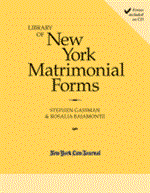There’s a potent myth surrounding prenuptial agreements: after entering a prenuptial agreement (a “prenup”), couples can rest assured that should they one day divorce, the process will be simple, neat, and painless. This is one of the most common misconceptions about prenups.
The ease of divorce proceedings for a couple with a prenup depends upon what type of agreement they signed, what that agreement says, and whether the prenup may inadvertently create litigable issues upon a divorce. When crafted without thoughtful consideration of the couple’s circumstances and property, a prenup can actually make for more confusion and a messier divorce.
There are two overarching structures that prenups typically follow (although there are variations and hybrids within each of these broad structures): title controls and mirror the law.
Under a strict title controls structure, the prenup will determine property upon divorce based upon titles, in accordance with the law that was in place in New York until 1980. Before 1980, divorce law was more traditional and sexist towards women; men were presumed to be the primary household earners.
No matter the contributions made by his partner to the marriage and household, the bank account and property, which were most often in the husband’s name, reverted to the title holder upon divorce. As a result, women ended up with much less and remained dependent upon their ex-husbands and maintenance (or alimony) after divorce.
In 1980, the statue changed to the Equitable Distribution of marital property: under this statue, what matters is not title but when and how the property was earned. This law views a marriage as an economic partnership, whether a partner is earning money out of the house or laboring at home without compensation.
As a result, all the economic fruits of the marriage are understood to be shared in an equitable manner. If a husband earned 10 million during the marriage, the wife could still walk away with 5 million, whereas prior to 1980 she would be left with nothing. Still, under the existing law, there remain, inter alia, two important categories of separate property: namely what each partner brings into the marriage, and what each partner acquires during the marriage from inheritance, gifts, or trust distribution.
Mirror the law prenups codify and formalize that the existing New York law regulates the couple’s agreement: everything earned during the marriage is marital property, and they typically stipulate that marital property will be divided equally, not equitably. A couple would enter this sort of prenup to provide themselves with more flexibility; given that every state’s law is different, these prenups protect the couple in the event that they move, or the state’s law changes.
For many couples who are beginning on their life’s journey together and whose separate property is not in their name (for example, a prospective interest or assets held in an irrevocable trust), a mirror the law agreement can be ideal: it seems to embody the kind of economic and life partnership they’re seeking in this new chapter of their life together.
Mirror the law prenups are often preferable for couples in which one partner may bring to the marriage considerable family money. When families do a good job with recordkeeping, or their property is held in trust, the divorce proceedings should be relatively straightforward because the vast majority of property titled in their individual names will be deemed marital, while future inheritance and what is held in trust will be protected as separate by the agreement regardless of which jurisdiction governs their divorce or how the law may change.
What is more, well-drafted and thoughtful prenups also provide downside protection for the less-monied partner by providing, for example, housing security or a safeguard if there isn’t much marital property, making the agreement a “win-win” for both sides.
However, mirror the law agreements still require that the couple determine what is marital and what is separate property. For couples whose assets are not neatly organized by the structures of family money, a mirror the law agreement can make for a messy divorce.
For example, if a wife earns several million dollars prior to the marriage and her husband brings to the marriage, by contrast, a more modest savings in his bank account, what will matter upon divorce with a mirror the law agreement in determining separate property is the accounting. If the couple has not been diligent about maintaining their records, their divorce may be messy and complicated, and the protections sought by the prenup may be obviated.
A case recently decided by Justice Ariel Chesler of the Supreme Court, New York County, Anonymous v. Anonymous, 2023 NY Slip Op 50198(U), provides breathtaking insight into how such a mirror the law agreement can complicate a divorce.
In Anonymous, the couple’s prenup defined separate property as “all property owned or acquired by such party before the effective date of this agreement,” including “deals in progress” as well as “income, rents and proceeds derived from or accrued upon such party’s separate property” and “the enhancement and appreciation in value of such party’s separate property.”
Article Six of the couple’s prenup provided a mechanism for the couple to determine separate and marital property upon divorce, which required that the couple conduct an annual “record keeping” with an accountant to maintain discrete marital and separate property.
The prenup stipulated meticulous requirements for this annual accounting to distinguish between the income derived from separate property and the income derived from marital property. During the marriage, and not surprisingly, neither party complied with these directives.
Both the defendant-wife and plaintiff-husband argued that Article Six should be dismissed: the defendant saw it was unenforceable because of the plaintiff’s alleged noncompliance, whereas the plaintiff argued that it was moot.
Justice Chesler held that Article Six must be enforced as a central feature of the prenup. Nearly three years of litigation ensued, with appeals and a complicated accounting and discovery process. The defendant, the less monied spouse, incurred roughly $855,732 in legal fees. Ultimately, the couple was ordered to submit disclosures to the designated accountant, and the plaintiff was ordered to pay $600,000 to the defendant’s counsel.
This case serves as a cautionary tale. While the couple and the judge could see the terms of the prenup were “unambiguous,” the agreement itself unnecessarily complicated the proceedings because of the terms that it set forth.
While the intent of the prenup was laudatory—to allow the couple to create an economic partnership by sharing in the fruits of the marriage while ring fencing the husband’s income derived from premarital sources––the actual application of the terms created burdens during the marriage that were nearly impossible to meet.
Instead of litigating for three years and incurring massive legal fees, both parties to this case could have likely walked away happier had a different kind of prenup presided over their divorce—even one that didn’t create a true economic partnership.
Smarter Approaches
In crafting a prenup, one of the most important questions to consider is whether the agreement creates any ongoing obligations during the marriage, beyond those required for major life events. While a couple with a prenup will likely need to consider the agreement’s terms when they buy a house, receive a large trust distribution, or come into an inheritance, they will not want to have to think about it in their day-to-day lives or when they file their annual taxes.
Prenups that require ongoing work oftentimes make for messy divorces. People in happy marriages, or people in unhappy and busy marriages, do not typically have the time, energy, or desire to complete the accounting that their prenups stipulate.
In cases where the partners’ earned assets prior to the marriage are remarkably different, it can be difficult but important for the couple to accept that they are unlikely to attain a conventional economic partnership through marriage.
Even though title control agreements are more draconian and represent a step back from the law, when written with a generous distributive award and additional protections for the less-monied spouse such as housing security, they can provide simpler and better settlements upon divorce.
When couples in these kinds of circumstances do decide to partake in an agreement that mirrors the law, their prenup should not include complicated provisions to segregate marital and separate income. If the couple is using a mirror the law agreement that does require accounting, they should determine a lookback period, and they should avoid any provisions that require them to look back at what happened for entirety of marriage, as that would likely result in an accounting disaster.
Alyssa Rower is the founding partner of Rower LLC, a New York law firm started in 2017 dedicated to matrimonial and family law.
NOT FOR REPRINT
© 2024 ALM Global, LLC, All Rights Reserved. Request academic re-use from www.copyright.com. All other uses, submit a request to [email protected]. For more information visit Asset & Logo Licensing.


 Alyssa Rower
Alyssa Rower






